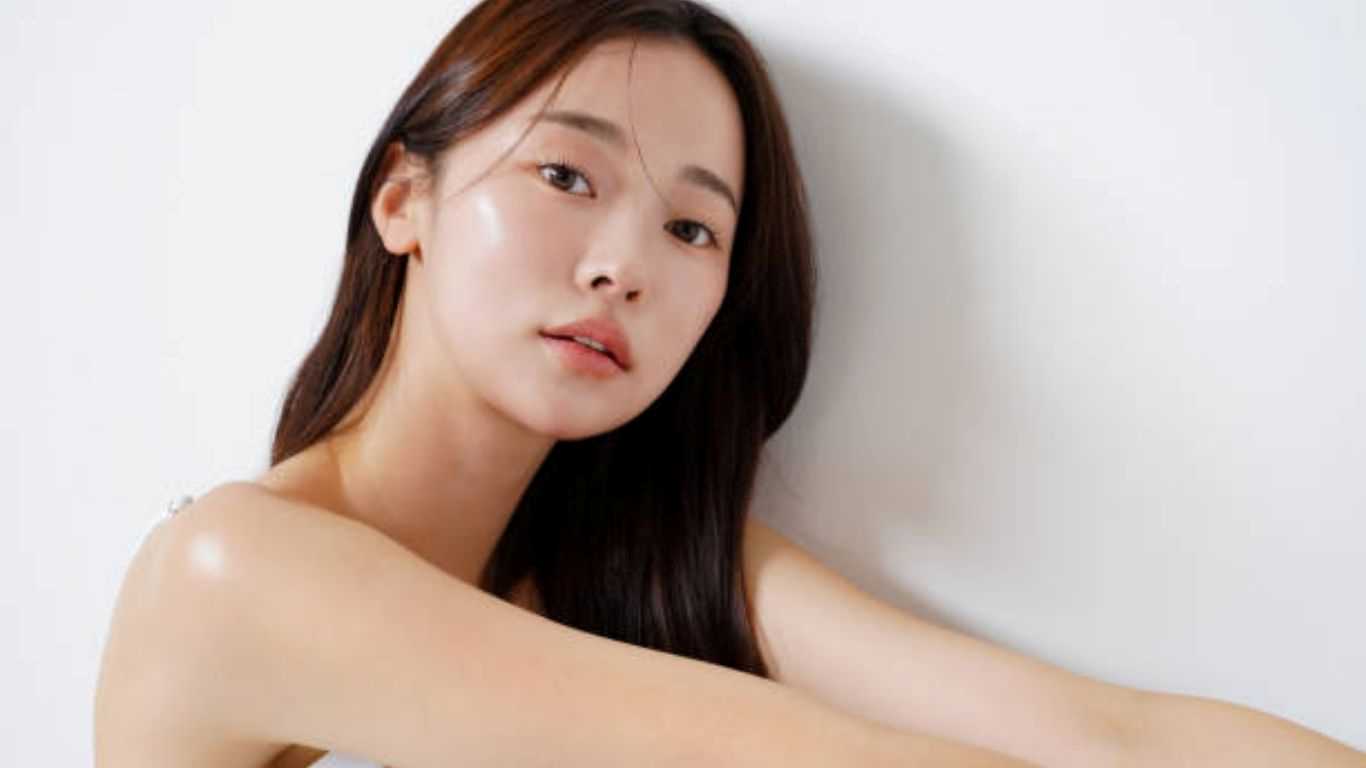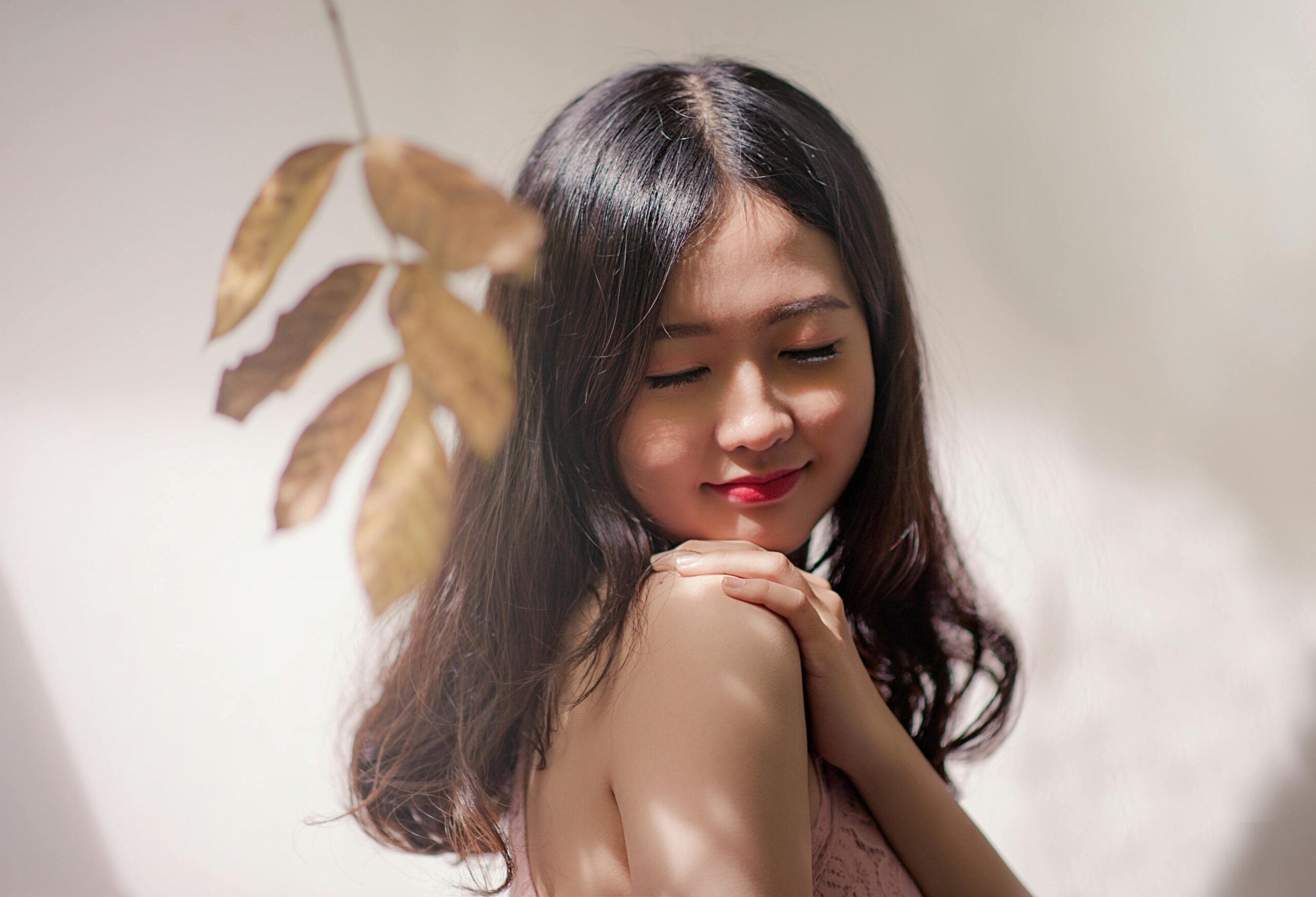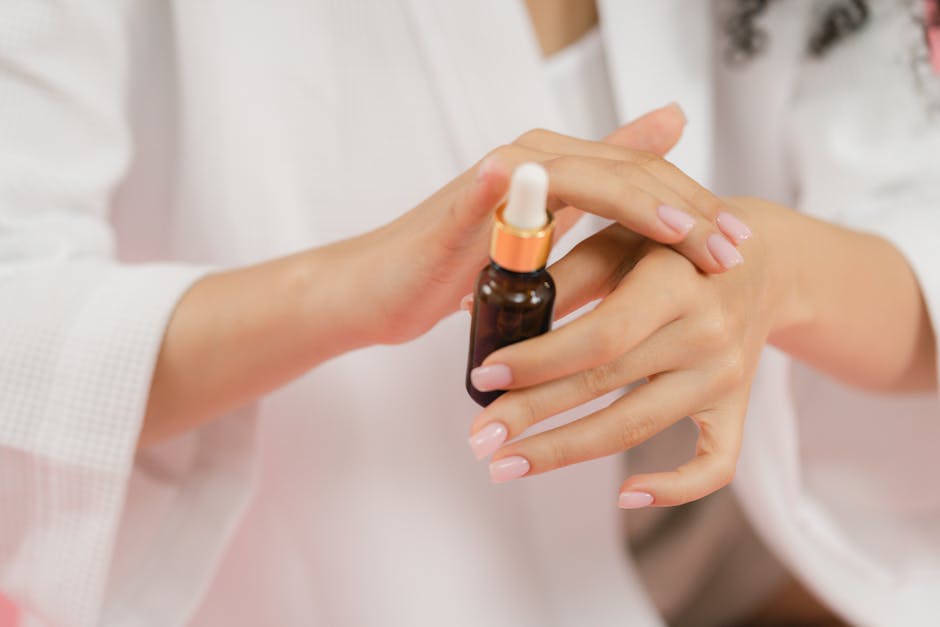Korean beauty has gained significant global influence, shaping beauty standards and trends far beyond Asia. As we look to 2025, Korean beauty ideals continue to emphasize a natural, healthy, and refined appearance, characterized by a V-shaped face, clear skin, and a slim, toned physique. Personalized augmentation is on the rise, blending classic Korean aesthetics with individuality and uniqueness. Eco-friendly K-beauty products are also in demand. In this article, we explore “Korean Beauty Standards: A Two-Sided Perfect Picture.”
Historical and Cultural Foundations
Korean beauty standards have deep roots that are steeped in history and culture. Light skin, for instance, was associated with royalty, while tanned skin was often indicative of labor. The influence of Confucian ideals, reinforced by elites and ruling classes, emphasized appearance and hygiene as signs of respect. These notions evolved into today’s focus on seeming ‘pure, ‘youthful,’ and ‘refined.’ The media continues to shape and uphold these standards in the collective consciousness, a testament to the enduring influence of historical and cultural factors on beauty standards.
Contemporary influences, particularly the Korean Wave (Hallyu), have significantly intensified these beauty standards. Influencers, K-pop idols, and K-drama stars often showcase meticulously maintained looks, achieved through fitness and cosmetic procedures, thereby setting the standard for younger audiences across various media platforms.
Cultural changes affecting how people view beauty
Korean beauty standards are being reshaped by the nation’s increasing openness and diversity. Individuality is now more valued, thanks to the influence of social media, which enables the rapid dissemination of new trends. Influencers and the public are promoting a wider range of looks, challenging old stereotypes and expanding the definition of beauty.
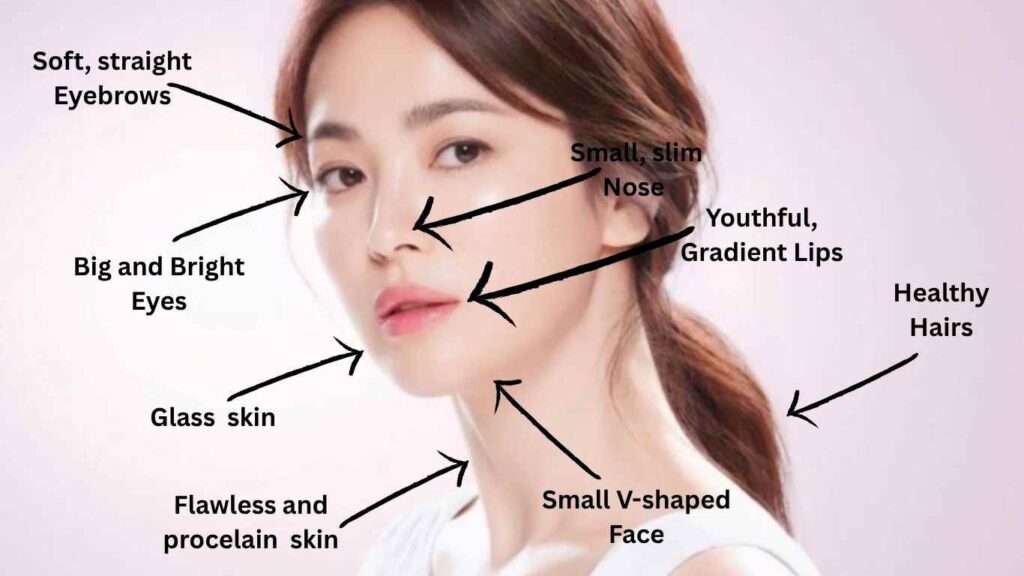
10 Korean Beauty Standards: A Two-Sided Perfect Picture
1. Flawless, Porcelain Skin
Clear, fair skin is an iconic K-beauty ideal. It refers to a pale, even complexion, once reserved for the elite. Now, it signals youth, health, and self-care. This fuels demand for sun protection, whitening essences, and blemish-control products. The popularity of powder compacts, BB creams, and multi-step skincare targeting hyperpigmentation reflects this trend.
2. Glass Skin
Glass skin is more than clear skin—it’s bright, nearly reflective, and appears hydrated and plump. Achieved by layering toners, essences, serums, ampoules, and moisturizers, this look signals a healthy, glowing face, not a matte one.
3. Small, V-Shaped Face
A slim, V-shaped jawline is prized for suggesting elegance and youth. Its cultural roots span from historical art to K-pop, reinforcing its link to sophistication. This ideal has driven facial exercises, contouring, and procedures like jaw reduction or chin fillers. The preference for a smaller face also aligns with Korea’s broader value for delicate features.
4. Big, Bright Eyes
Western beauty ideals often feature deep-set eyes, whereas K-beauty values wide, innocent-looking eyes. Many Koreans use circle lenses to make their irises look larger and apply eyeliner techniques that open the eyes rather than elongate them. Double eyelid surgery, also known as “ssangapul,” remains a standard procedure that aims to create a natural crease, making the eyes appear rounder and bigger. Eye makeup trends often focus on soft, shimmery shadows to emphasize brightness over boldness.
5. Straight, Soft Eyebrows
Korean beauty favors straight, gently curved brows, which are distinct from the high Western arches. This style gives a younger, friendlier look, aligning with innocence and grace. Brow tints, pencils, and microblading keep this serene effect.
6. Small, Slim Nose
A slim, slightly upturned nose is desirable. Many celebrities achieve this with rhinoplasty or fillers. Subtle nose contouring adds definition without looking heavy. The goal is a delicate nose that complements, not dominates, the face.
7. Youthful, Gradient Lips
Korean lip trends favor soft, blurred edges rather than bold lines. The “gradient lip” deepens in color at the center and fades outward, creating a fresh, youthful effect that mimics naturally rosy lips.
8. Lilliputian Body Frame
In Korea, slenderness is viewed as a sign of self-discipline and care. The ideal body is petite, characterized by delicate limbs and a slender waist. Admired slimness stops short of extreme thinness, but idols inspire strict diets and workouts. Experts highlight the health impact, prompting discussions about body positivity. However, this focus on maintaining a slim physique comes with specific health risks. Excessive dieting and exercise can lead to nutritional deficiencies, fatigue, and metabolic issues. Additionally, such pressure can adversely impact mental health, resulting in anxiety, body dysmorphia, and low self-esteem. Addressing these concerns is vital to fostering a more inclusive and healthy perception of beauty.
9. Glossy, Healthy Hair
Healthy, shiny hair is another sign of beauty. Hair should look natural and well-kept, rarely teased or stiffened with products. Hair masks, scalp scrubs, and serums are popular. The aim is fluid, glossy hair that, like the skin, reflects radiance.
10. Aegyo-sal (Cute Under-Eye Bags)
In Korea, ‘aegyo-sal’—small under-eye bags—signals youth and friendliness. Many enhance this feature with makeup or fillers to make eyes seem larger and more approachable.
Are Korean Beauty Standards the Same for Men and Women?
Men and women in Korea face similar beauty pressures, although expectations vary in degree and focus. Men are encouraged to maintain a clean, sharp look, identical to that of K-pop idols, but expressions of masculinity are diversifying. Some male influencers challenge norms by promoting positivity and unique styles, showing multiple ways masculinity is navigated in Korea.
Shared Expectations
Both men and women are expected to have:
- Clear, pale skin
- Slim figures
- Small, symmetrical faces with sharp jawlines
- Double eyelids and big eyes
- Neatly groomed appearance
Expectations for Women
- For women, the standards go further and are often stricter:
- V-line jaw and small face
- Long legs, S-line curves, and a tiny waist
- Babyface
- Makeup is expected in most social and professional settings.
Expectations for Men
Korean men are also held to high standards, though with different subtlety:
- Flawless skin and facial symmetry
- Slim but toned body
- “Soft” but masculine—a style favorite by K-pop idols.
- Even daily, cosmetic use (BB cream, eyebrow shaping, lip tint) is normalized.
- There is an increasing demand for procedures like jawline sculpting and rhinoplasty among men.
The Beauty Industry’s Function
Korea’s advanced beauty industry sets and maintains these ideals through nonstop marketing, the introduction of new products, and celebrity endorsements. Consumers often feel pressured to pursue perfection, as products such as diet teas, whitening lotions, and cosmetic surgery are marketed as means of self-improvement. A recent TikTok trend, ‘Cheeks on Fleek,’ has increased demand for cheek products, resulting in the introduction of new blush and serum lines. Influencer-driven campaigns quickly turned this trend into a routine staple.
Plastic surgery is increasingly common. South Korea has one of the highest rates of cosmetic procedures per capita. High school graduates may consider eyelid surgery as a gift, and job seekers often modify their appearance to increase their chances of getting hired.
Impact and Reaction Worldwide
Korean beauty standards are no longer limited to South Korea, thanks to the global appeal of K-beauty and K-pop. These aesthetics have a profound impact on fans and customers worldwide, who may follow skincare regimens or even undergo surgery to emulate the appearance of Korean celebrities.
Criticism of beauty standards is on the rise in both Korea and abroad. Young Koreans increasingly resist. Women in the ‘Escape the Corset’ movement cut hair, skipped makeup, and rejected strict norms.
This movement emerged as a reaction to the pressure of maintaining high beauty standards, aiming to empower women to define their own identities outside societal expectations. The ‘Escape the Corset’ movement’s goals are to challenge and dismantle the rigid expectations placed on appearances. A viral clip showed a woman cutting her hair live, proclaiming freedom from femininity expectations to thousands of viewers. These moments show the participatory drive of this movement. Its impact is evident as social media continues to fuel a more diverse group of influencers who challenge the traditional idea of beauty, emphasizing authenticity and personal choice.
Social media and content created by users
Platforms like Instagram and TikTok speed up trends daily. Viral challenges, tutorials, and before-and-after clips set new expectations. Online communities swap ideas, making beauty trends more accessible and diverse.
Next, to grasp these standards in context, let’s compare them to American beauty ideals.
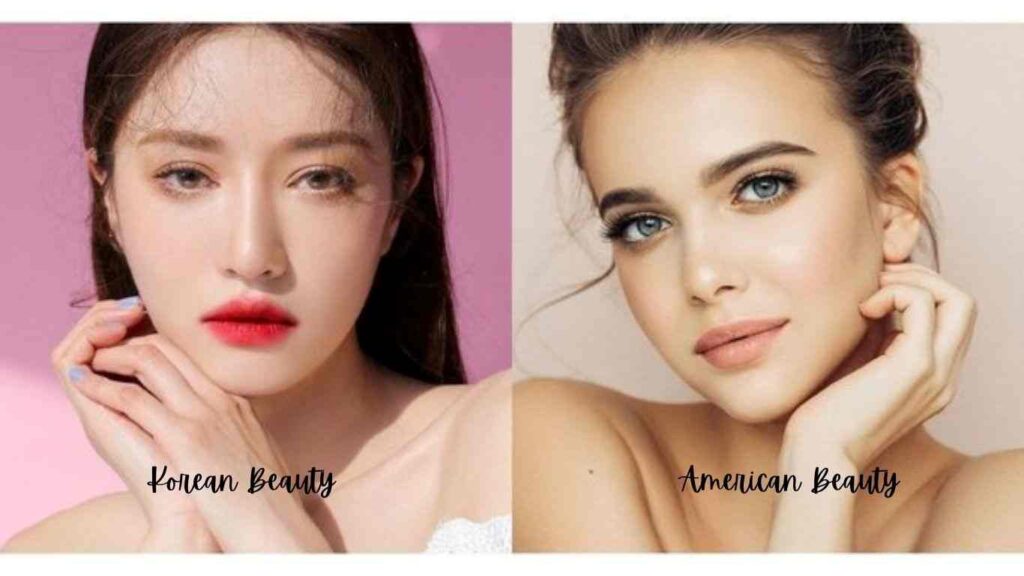
Korean Vs American Beauty
1. Natural vs. Enhanced Natural
Korea:
Korean beauty emphasizes natural enhancement, creating an appearance that is beautiful yet understated by subtly enhancing features.
America:
Korean beauty emphasizes subtle, natural enhancements with a harmonious, understated appearance. American trends, however, favor noticeable, bold enhancements, such as dramatic contouring and statement makeup. These contrasting priorities reflect cultural differences: Korea values blending in, while America values standing out. Knowing this contrast helps consumers better interpret beauty standards across cultures.
2. Skin: Glow vs. Sculpture
Korea:
The foundation of Korean beauty is transparent, fair, and radiant skin. Pale skin historically signified higher status, and that preference remains strong today.
America:
Healthy skin is essential in both cultures, but Americans often prefer a sun-kissed look achieved with bronzer, self-tanner, and golden highlights. This suggests an active, outdoor lifestyle, which contrasts with Korea’s pursuit of fair, radiant skin as a symbol of status and diligence in skincare.
3. Facial Dimension: Youth vs. Definition
Korea:
Korean beauty ideals emphasize facial youthfulness, characterized by large, round eyes, a slender nose, and a gentle, V-shaped jawline. Straight eyebrows and a light blush enhance this image of innocence and refinement.
America:
American standards prize bold, well-defined features such as high cheekbones, fuller lips, and sculpted jawlines. Makeup techniques like arched brows, smoky eyes, and vibrant lips project confidence and maturity, offering a direct contrast to Korea’s focus on youth, gentleness, and innocence.
4. Body Image: Slim vs. Fit
Korea:
In Korea, the preferred body shape is petite and slender, with a preference for long legs and a narrow waist. Muscle definition and athletic builds are less valued in America, where a fit and curvaceous physique is often seen as more feminine and attractive.
America:
America’s ideal body type is typically more athletic and curvaceous than Korea’s, highlighting muscle tone, defined abs, and prominent curves at the bust and hips. This reflects a different set of cultural values about appearance.
5. Hair: Natural vs. Styled
Korea:
Korean beauty standards consider glossy, healthy hair that flows naturally an ideal, with understated coloring and minimal, extreme styling. This contrasts with American trends, which often embrace dramatic styles, bold colors, and ever-changing hair choices, favoring individuality.
America:
In the U.S., hair trends are characterized by frequent change and experimentation, with a focus on bold colors, varied textures, and dramatic styles. This openness to diversity emphasizes individuality, in contrast to Korea’s more natural approach.
6. Makeup Philosophy: Cute vs. Sexy
Korea:
K-beauty makeup aims for a cute, innocent effect called ‘aegyo,’ achieved through the use of soft pink blush, subtle gradient lips, and bright eyes. This gentle approach highlights Korean standards for youth and sweetness, in contrast to American emphasis on glamour and sex appeal.
America:
American makeup often aims for a bolder, more glamorous look—smokey eyes, defined contours, and full lips—which conveys confidence and sex appeal, in clear contrast to Korea’s lighter aesthetic.
7. Surgery and Enhancement: Subtle vs. Statement
Korea:
Cosmetic surgery is common in Korea, but the focus is on subtle improvements—such as eyelid surgery or gentle jaw reshaping—so features appear natural, not obviously altered. This subtlety contrasts with America’s openness to visible, pronounced surgical changes.
America:
In the U.S., cosmetic procedures can range from subtle to conspicuous, including lip and breast enhancement. Visible changes are often openly discussed and even showcased, reflecting greater societal acceptance of dramatic transformation.
8. Cultural Roots: Collectivism vs. Individualism
Korea’s collectivist culture encourages individuals to adhere to beauty ideals that promote social harmony and acceptance. As a result, there is a strong emphasis on adhering to shared standards rather than standing out, which contrasts with America’s focus on uniqueness.
America’s individualism values personal uniqueness, and this is reflected in rapidly evolving beauty trends and a broad acceptance of different looks, even those that diverge sharply from the mainstream ideal.
9. Aging: Delay vs. Embrace
Korea:
Korean attitudes toward aging are proactive and preventative: anti-aging skincare is popular and often marketed to people in their twenties, encouraging early intervention for lasting youthfulness.
America:
In America, anti-aging is a leading trend. Still, a growing number of influencers—especially those over 40 or 50—actively promote acceptance of natural aging, gray hair, and wrinkles, reflecting a shift in attitudes.
Final Words
Korean beauty standards reflect a culture rich in discipline and a strong emphasis on presentation. Yet, the pursuit of perfection can become overwhelming when it shifts from a choice to a requirement. While such ideals fuel global trends and commerce, they also drive anxiety and unrealistic self-expectations. Still, change is underway: movements like ‘Escape the Corset’ and diverse influencers are creating space for greater inclusivity and acceptance. As these new voices gain ground, the promise grows for a future where beauty is defined by individuality, not conformity. Supporting diverse media and products today helps move us closer to a world where unique beauty is truly seen, respected, and celebrated—one step at a time.
FAQs
1. Why are Korean beauty standards so toxic?
A mix of traditional values, modern media influence, and societal expectations shapes Korean beauty standards. In Korea, success is strongly correlated with appearance, particularly in terms of relationships, career advancement, and public perception. This strongly emphasizes maintaining a polished and “ideal” look.
2. Are Korean beauty standards the same for men and women?
While women face more pressure, Korean men are also held to high standards. Male actors and idols are expected to have slender bodies, clean and fashionable looks, clear jawlines, and flawless skin. Cosmetic use among men is everyday and socially accepted.
3. Is plastic surgery common in South Korea?
Indeed. South Korea has one of the highest rates of cosmetic surgery per capita in the world. Standard procedures include double eyelid surgery, rhinoplasty, and jawline contouring. Cosmetic surgery is often seen as a form of self-investment.
Do you know that, in comparison to one in twenty American women, every fifth Korean woman has had plastic surgery?
4. Why is pale skin preferred in Korea?
In the past, pale skin signified a higher social status, as it was tacit that one did not work outdoors. Today, it’s associated with purity, cleanliness, and youth. Many skincare products in Korea include brightening or whitening ingredients.
5. How do Korean beauty standards affect mental health?
The pressure to conform can lead to low self-esteem, body image issues, and even depression. Constant comparison, especially on social media, can make individuals feel incompetent if they don’t meet these ideals.
6. What does “S-line” body mean?
“S-line” is a Korean term for a curvy but slim body shape—specifically, a defined bust, waist, and hips. It’s often idealized in female celebrities and models, though most still maintain slim figures.

